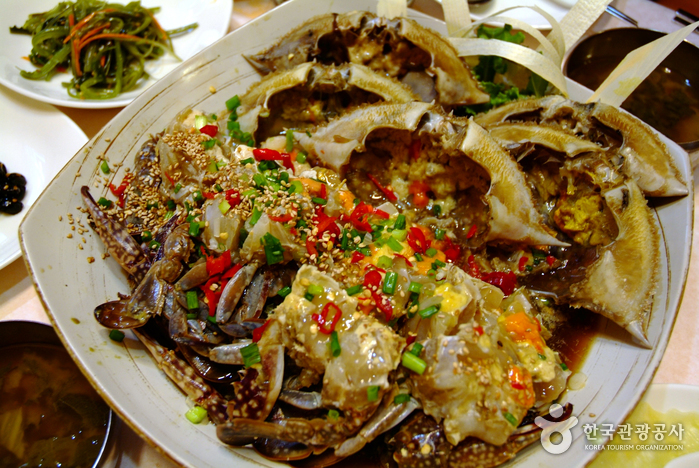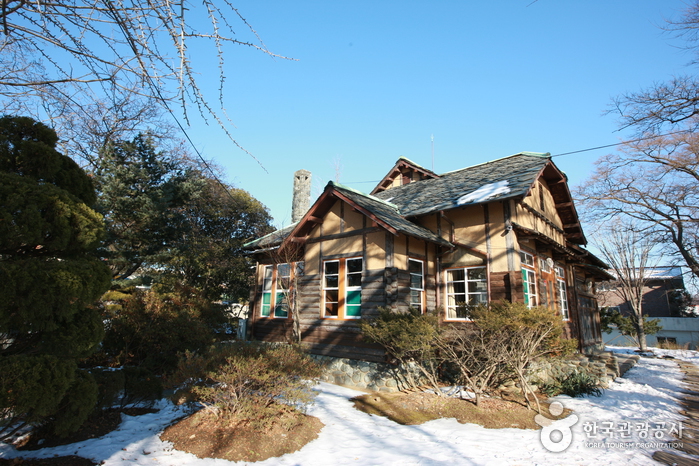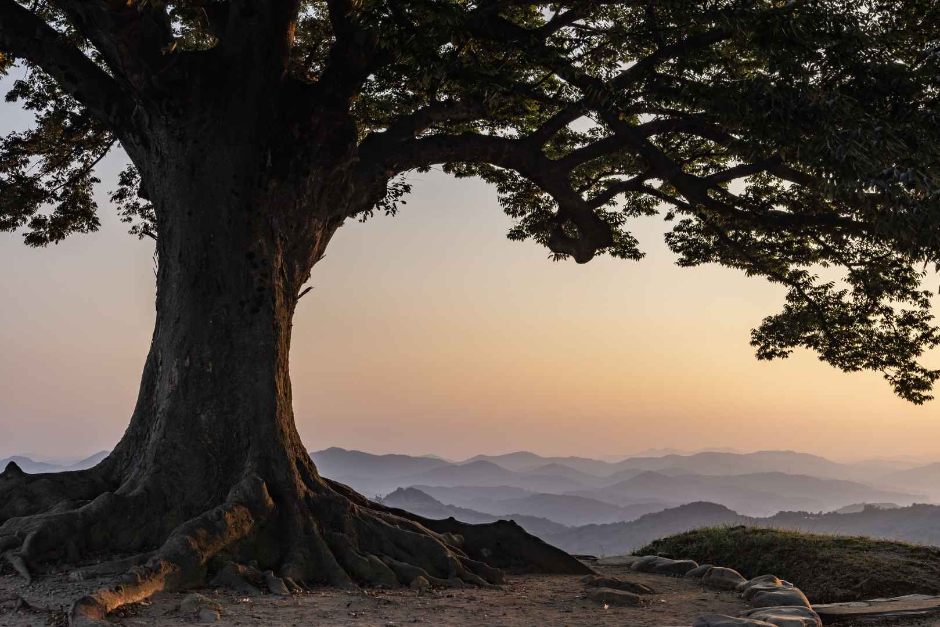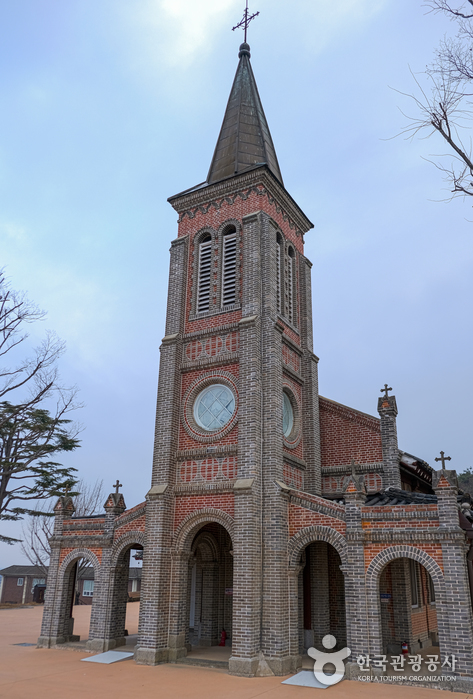Gyegok Garden Kkotgejang (계곡가든꽃게장)
12.3Km 2024-04-07
470 Geumgang-ro, Gaejeong-myeon, Gunsan-si, Jeonbuk-do
Gyegok Garden Kkotgejang is a restaurant sought after by food enthusiasts nationwide, renowned as the first establishment in the country to patent gejang (marinated crab) cuisine. Originally selling dwaeji galbi (grilled pork galbi), the restaurant's main dish shifted to crab after its exceptional kkotge jang (soy sauce marinated crab) side dish garnered increasing attention from customers seeking gejang delicacies. The secret to its flavor lies in the authentic soy sauce, aged with 16 medicinal herbs, and the plump meat of female crabs. Customers can enjoy gejang with minimal fishy or salty taste, instead relishing in the rich and savory flavor of the crab.
Deoksugung Haemul Kalguksu (덕수궁해물칼국수)
12.3Km 2024-02-28
5, Jangsan-ro 855beon-gil, Maseo-myeon, Seocheon-gun, Chungcheongnam-do
041-956-7066
Located near the Geumgang Estuary Embankment, Deoksugung Haemul Kalguksu serves haemul kalguksku (noodle soup with seafood) full of clams and vegetables. Kalguksu (noodle soup) is made by rolling out a thin flour dough, slicing it into thin strips, and then boiling them in a soup. There’s a variety of kalguksu (noodle soup) dishes on offer, along with wangmandu (jumbo mandu). The broth is clean, thanks to shrimp and fresh vegetables. Don’t miss yeolmu kimchi (young summer radish kimchi), which is served as a side dish in the restaurant and goes perfectly with kalguksu (noodle soup).
Surawon (수라원)
13.9Km 2024-02-26
641-9, Jangsan-ro, Janghang-eup, Seocheon-gun, Chungcheongnam-do
0507-1435-6250
Surawon is a hanu (Korean beef) and bulgogi restaurant located at the estuary where the Geumgang River meets the Yellow Sea, allowing visitors to have a great view of the sea, the river, tidal flats, and the city of Gunsan beyond the river. The menu includes seoksoe bulgogi (grilled bulgogi), dwaeji galbi jjim (braised pork galbi), so galbi jjim (braised beef galbi), and hanu gui (grilled Korean beef). The nearby Geumgang Estuary Embankment is famous for the view of thousands of migratory birds dancing above the water, while the city of Gunsan across the Dongbaekdaegyo Bridge is known for its modern architecture and historical sites.
House of Lee Young-choon (이영춘가옥)
14.0Km 2024-04-07
7, Donggaejeong-gil, Gunsan-si, Jeonbuk-do
+82-63-454-3922
The House of Lee Young-choon was constructed by
a Japanese landlord named Kumamoto during the Japanese colonial era. The house combined Western, Korean, and Japanese into one structure. After Korean liberation, Dr. Lee Young-choon, the first medical doctor, lived in the house. From that time, the house was referred to as the
House of Lee Young-choon.
Thanks to its beautiful exterior, the house was used as a backdrop for films such as Bingjeom, Sandglass, and Yain Shidae, etc.
The doctor was considered the Korean "Albert Schweitzer", and his
pen name of "Ho", referring to ssangcheon,
means "two branches of spring water, represents one for healing physical disease and the other for healing the
spirit. He was born in Yonggang-gun, Pyeongannam-do in October 1903. In 1935,
through a connection by his professor at Pyeongyanggobo School, he took a position
as the head of Jahye Hospital to take care of 20,000 people. In addition, he was the first person
in Korea to implement the policy of school nurses as well as the medical insurance union.
Wonkwang University Hospital (원광대학교병원)
14.4Km 2025-10-23
895 Muwang-ro, Iksan-si, Jeonbuk-do (54538)
WONKWNAG UNIVERSITY HOSPTIAL leads the advancement of medical care in Jeollabuk-do by centering on excellent medical personnel and introducing the latest medical equipment.
We are the first in the Jeonbuk State to receive the KAHF (Korean Accreditation Program for Hospitals serving Foreign Patients). Our hospital is a tertiary hospital equipped with a Jeonbuk Regional Cardiocerebrovascular Disease Center, Trauma Center, Regional Emergency Medical Center, and a multi-person hyperbaric oxygen therapy chamber.
As a renowned cancer specialist, we have consistently attained the highest level, Grade 1, in all four major cancer care assessments (colon cancer and stomach cancer for 7 consecutive years, and breast cancer and lung cancer for 6 consecutive years) conducted by the Health Insurance Review and Assessment Service (HIRA). With a team of specialists dedicated to developing cancer treatments, it provides specialized cancer management service. In particular, we have established a collaborative treatment system essential for patients with severe cancer through multidisciplinary integrated treatment by internal medicine, surgery, rehabilitation medicine, and oriental medicine hospitals together, and performed cancer surgeries with a high degree of difficulty on a large number of patients every year.
Buyeo Garimseong Fortress (부여 가림성)
14.6Km 2025-10-23
167 Seongheung-ro 97beon-gil, Imcheon-myeon, Buyeo-gun, Chungcheongnam-do
+82-41-830-2880
Garimseong Fortress is a stone fortress built on the lower reaches of the Geumgang River to protect Sabiseong Fortress, the capital of the Baekje dynasty. The fortress' parking lot is only 200 meters away from the southern entrance, allowing visitors to easily access and enjoy the view from this historical fortress. By ascending the stairway by the rocky cliff, a large tree comes into view. Known to be over 400 years old, this tree is called the "Love tree of Seongheungsan Mountain" and has even made an appearance in the drama "Seodongyo (200)." The fortress is also popular as a sunrise spot, serving as Buyeo-gun’s New Year's Eve festival venue.
◎ Travel information to meet Hallyu’s charm - TV series "Hotel Del Luna"
From Man-wol’s friendship with Yeon-woo to her anger toward Chung-myung in “Hotel Del Luna,” Buyeo Garimseong Fortress has become a popular social media hotspot. Offering a panoramic view of Buyeo’s cityscape, the fortress became a new social media hotspot as it offers a unique photo opportunity under a zelkova tree called the “love tree.”
Nabawi Catholic Church (화산천주교회(나바위 성당))
14.6Km 2024-04-07
146, Nabawi 1-gil, Iksan-si, Jeonbuk-do
+82-63-861-9210
Nabawi Catholic Church is located in Hwasan-ri, Mangseong-myeon in Iksan, Jeollabuk-do Province and is known as the oldest surviving catholic church in the Jeolla-do region. The church was built in 1906 to commemorate the return of priest Kim Dae-geon in 1845 (Joseon dynasty) after he was ordained in Shanghai, China. Inside the church stand two monuments: one built in 1954 to honor Joseph Vermorel (French missionary, 1860-1937) and one built in 1955 to honor priest and martyr Kim Dae-geon. Considered the most significant catholic relic of the Jeolla-do region, the church is sought out by large numbers of Catholic visitors each year.
E-Mart - Gunsan Branch [Tax Refund Shop] (이마트 군산)
14.8Km 2024-04-23
137, Guam 3.1-ro, Gunsan-si, Jeollabuk-do
-
Adidas - Lotte Mall Gunsan Branch [Tax Refund Shop] (아디다스 롯데몰군산)
14.8Km 2024-04-17
130, Jochon-ro, Gunsan-si, Jeollabuk-do
-
Uniqlo - Lotte Mall Gunsan Branch [Tax Refund Shop] (유니클로 롯데몰군산)
14.8Km 2024-04-18
1F, 130, Jochon-ro, Gunsan-si, Jeollabuk-do
-





![Adidas - Lotte Mall Gunsan Branch [Tax Refund Shop] (아디다스 롯데몰군산)](http://tong.visitkorea.or.kr/cms/resource/78/2888278_image2_1.jpg)
![Uniqlo - Lotte Mall Gunsan Branch [Tax Refund Shop] (유니클로 롯데몰군산)](http://tong.visitkorea.or.kr/cms/resource/14/2888414_image2_1.jpg)
 English
English
 한국어
한국어 日本語
日本語 中文(简体)
中文(简体) Deutsch
Deutsch Français
Français Español
Español Русский
Русский